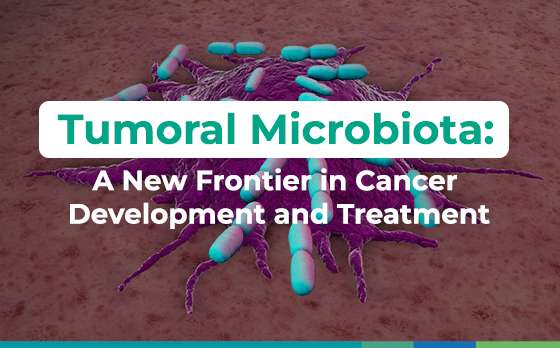Introduction
The human microbiota consists of approximately 38 trillion microorganisms, including bacteria, fungi, and viruses, comparable in number to human cells. These microorganisms, previously associated with open cavities and organs like the gut and skin, have also been found in tissues and organs once thought to be sterile, such as the lungs, breasts, liver, kidneys and brain. This discovery has propelled research in related areas, revealing the presence of intratumoral microbiota in at least 33 types of cancer. This microbiota, which forms part of the tumor microenvironment, may influence cellular biology, affecting the occurrence and development of cancer, as well as the antitumoral immune response.
Since the 19th century, microorganisms have been observed in tumors. In 1885, Doyen isolated Micrococcus neoformans from different tumors, suggesting its tumorigenic capability, although limited sterile conditions questioned these findings. In the 20th century, it was discovered that avian sarcoma could be transmitted, leading to the recognition of viruses as carcinogenic agents, corroborated by the discovery of the Epstein-Barr virus in 1964. Research has continued, including the role of H. pylori in gastric cancer and recent studies exploring intratumoral microbiota in various types of cancer.
Microorganism-based treatments have evolved since 1866, when Busch intentionally infected patients with erysipelas, observing tumor regression, to the creation of the anticancer vaccine by Coley in 1893. Currently, the use of engineered bacteria and viruses for cancer treatment is under investigation.
This review thoroughly examines the characteristics and functions of intratumoral microorganisms in various tumors, their impact on cancer development and immunity, and the future applications of intratumoral microbiota in cancer prognosis and treatment.
Characteristics of Intratumoral Microbiota
Microbial Colonization of Tumors
Intratumoral microorganisms can originate from the invasion of mucosal barriers, adjacent tissues, or hematogenous routes. For example, the conductor-passenger model proposed by Tjalsma suggests that certain bacteria may initially promote tumorigenesis, later being replaced by “passenger” bacteria. Intratumoral microbiota has been identified in mucosal and non-mucosal organs, such as the pancreas, where intestinal microorganisms alter the tumor microenvironment.
Diversity of Intratumoral Microbiota
It has been observed that intratumoral microbiota varies according to cancer type. In lung cancer, for example, an increase in Modestobacter has been recorded, while in liver cancer, H. pylori is associated with hepatocarcinoma. In colorectal cancer, carcinogenic bacteria such as Fusobacterium and Bacteroides fragilis have been identified. Gastric cancer shows a change in microbial abundance that could be used as a biomarker, while breast cancer presents microbial diversity suggesting diagnostic applications. The microbiota in pancreatic cancer also shows differences from healthy tissues, indicating a link to the aggressive nature of this disease.
Genomic Instability, Epigenetic Modifications, and Chronic Inflammation in Cancer Development
Genomic instability and mutations, significant carcinogenic mechanisms, are linked to the microbiota. Oncogenic viruses can integrate their genomes into the host chromosomes, causing mutations and producing oncoproteins that disrupt immune signaling. Furthermore, some bacteria induce DNA damage and epigenetic alterations, silencing tumor suppressor genes and activating oncogenes.
Chronic inflammation, often initiated by intratumoral microorganisms, creates a microenvironment conducive to tumor growth. Despite the immunosuppressive effects of some microorganisms, there is also evidence that intratumoral microbiota may activate immune responses, suggesting therapeutic potential.
The abundance of Fusobacterium nucleatum has been associated with poorer survival in various cancer types, such as vulvar squamous cell carcinoma and pancreatic cancer, although in some cases, like oral squamous cell carcinoma and anal squamous cell carcinoma, an opposite effect has been observed. This suggests that the immune response provoked by certain groups of microorganisms could influence postoperative survival. Besides F. nucleatum, other microorganisms also affect prognosis in different cancer types, such as the orders Actinomycetales and Pseudomonadales in non-small cell lung cancer.
Intratumoral microbiota is also related to therapy effectiveness. A higher level of F. nucleatum can reduce the efficacy of chemotherapy in esophageal carcinoma, while some bacteria, such as Clostridium, are associated with positive responses in patients with metastatic melanoma receiving immunotherapy. Conversely, infection with H. pylori has been linked to favorable outcomes in gastric cancer, although its presence may negatively affect the efficacy of immune checkpoint inhibitors.
Research on microbiota as a prognostic factor continues to develop, and its potential in personalized medicine could be significant if properly validated. However, obtaining tumor tissue samples is complicated, often leading to the use of alternative samples. New technologies and bioinformatics approaches could enhance cancer detection and prognosis by integrating data from multiple omics.
Cancer therapy is exploring the use of antibiotics and bacteriophages to improve patient survival by reducing chemotherapy resistance, although the use of antibiotics can alter the gut microbiota. Oncolytic viruses (OVs) are also utilized to target cancer cells and stimulate the immune response, showing greater efficacy when combined with other therapies.
Additionally, manipulating the microbiota through fecal transplants (FMT) and probiotics has potential to enhance immunotherapy. The role of intratumoral microorganisms in treatment efficacy is still not fully understood. The relationship between microbiota and clinical markers is another aspect that requires investigation.
Bullman suggests a mutualistic relationship between cancer cells and the intratumoral microbiota, indicating that modifying it could be a viable therapeutic strategy. Research on microbiota in cancer is in its early stages, and better models and interdisciplinary approaches are necessary. Identifying microbial differences between healthy individuals and those at risk could improve cancer prevention and diagnosis, opening new opportunities for treatments based on microbial signatures.
Reference: Yaqi Cao, Hui Xia, Xueyun Tan, Chunwei Shi, Yanling Ma, Daquan Meng, Mengmeng Zhou, Zhilei Lv, Sufei Wang, Yang Jin (10 January 2024). Intratumoural microbiota: a new frontier in cancer development and therapy. Signal transduction and targeted therapy, 9(1), 15. https://doi.org/10.1038/s41392-023-01693-0


